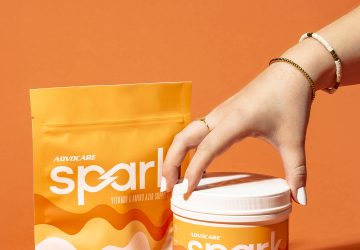Meal planning and prepping may seem overwhelming when you first start, but it can actually help make your life easier later in the week. It’s also important to remember that you don’t have to be a gourmet chef every single day. You can repurpose certain foods, use steam-in-the-bag veggies and pre-prep a variety of foods and dishes so that healthy eating seems easier during the week. Ultimately, meal planning and prepping can help you:
Discover More AdvoCare Free Healthy Living Resources
- Stay organized – If you plan out your meals, then you know what you need from the grocery store and how much time those meals will take so you can plan accordingly. When people don’t have a plan for breakfast, they often skip it! When there is no prep for lunch or dinner, people usually will opt to go out or drive through a drive thru.
- Make healthier, more mindful choices – When you are prepared with meals and snacks, it can help you avoid temptation. Many people choose a less healthy option when they are not prepared.
- Save money – Planning ahead, making a grocery shopping list and having healthy meals and snacks available is typically cheaper than eating out or grabbing food on-the-go.
- Save time – Taking a few hours to meal prep one day a week can help you save time the other six days, as well as make better choices.
- Decrease stress – When everyone in the car is saying, “I’m hungry! What’s for dinner?”, stress often rises, and the easiest choice is usually what happens. Having a dinner plan and even a plan B can help decrease night-time stress.
What does a meal prep plan look like?
- Grocery shop – Create a plan, make a grocery shopping list and stick to it!
- Tip: Stick to the outer edges of the grocery store for most of your shopping, as this is typically where you find produce, dairy, meat and other whole foods. When you go through the aisles, be on the lookout for high fiber, less processed carbohydrates like whole grain breads, quinoa, rice, etc., healthy fats like nuts, seeds and nut butters, spices to cook with, etc.
- If you’re getting condiments, be mindful of the sugar and sodium content – Take a look at the food label and ingredient list to double check your choice.
2. Make breakfast easy – Breakfast can be a struggle for many people due to morning time constraints so prep what you can beforehand.
- The AdvoCare Meal Replacement Shakes are a great option to mix in advance or in the morning. They can also be used to make overnight chia pudding, so they are ready for an on-the-go morning.
- Overnight oats are a great pre-prep breakfast idea! Adding milk or yogurt to oats in a jar (with a lid) and mixing in some of your favorite nut, seed and fruit toppings can make getting fiber and protein easy and tasty in the morning.
- Egg muffin cups are another great way to prep breakfast. Choose a cheese, meat and vegetable and whip up a batch on the weekend. These cook just like muffins, so simply scramble eggs in a bowl, add your ingredients of choice, salt and pepper to taste and evenly distribute in a muffin tin and bake at 350 degrees F for 20-22 minutes, or until eggs are cooked. Store the egg muffins in an airtight container and just like that, you have protein ready to go for busy mornings.
3. Produce prep – When you get home, take time to peel, chop and cut all your produce.
- Put prepped veggies and fruit into containers in the fridge so that they are easy to grab for a snack or to toss into a dish for an easy dinner.
- Roasting is a delicious way to eat vegetables and often a great way to learn to like other veggies. Roasting can also help save time because they can stay fresh in the fridge up to five days, making veggies an easy addition to weeknight meals.
- Drizzle your veggies with olive oil, herbs and spices then cook on 400 degrees F for approximately 45 minutes, or until tender. Store in an air-tight container in the refrigerator.
4. Snack-baggie tempting foods – If foods that come in large packages like nuts and crackers tempt you to eat too many, try snack bagging them right after you get home from the grocery store. Use the serving size on the box or bag to determine how many servings are in the container. From there, get out that many snack baggies and separate. This will make your life easier when it comes to snack time during the week as well as help you watch your portion sizes.
5. Pick one or two proteins for the week – Having protein options already cooked can make it easier to increase meal variety.
- Choose one to two protein options that can be used in a variety of meals and cook those on your prep today.
- Flavoring your protein with basic seasonings can make it easier to add to various dishes.
- For example, cook chicken in a crockpot to be used for a basic carb-protein-veggie meal, wrapped up in chicken lettuce tacos, tossed into a soup or as a protein addition to a salad. Similarly, ground beef or turkey can be used in tacos, taco salad, zucchini-noodle pasta dishes and even in breakfast scrambles.
 Amy Goodson, MS, RD, CSSD, LD is a registered dietitian, a Certified Specialist in Sports Dietetics, and a paid contributor to the AdvoCare blog. She focuses on overall health, wellness and sports nutrition. Amy has worked with the Dallas Cowboys, Texas Rangers, TCU Athletics, Ben Hogan Sports Medicine and more. She is a co-author of Swim, Bike, Run, Eat and nutrition contributor to retired NFL Player Donald Driver’s book, The 3-D Body Revolution. She is a writer for Women’s Running Magazine and is the owner of RD Career Jump Start, a business designed to help dietetic students, interns and new registered dietitians determine and take the steps necessary to reach their dream career.
Amy Goodson, MS, RD, CSSD, LD is a registered dietitian, a Certified Specialist in Sports Dietetics, and a paid contributor to the AdvoCare blog. She focuses on overall health, wellness and sports nutrition. Amy has worked with the Dallas Cowboys, Texas Rangers, TCU Athletics, Ben Hogan Sports Medicine and more. She is a co-author of Swim, Bike, Run, Eat and nutrition contributor to retired NFL Player Donald Driver’s book, The 3-D Body Revolution. She is a writer for Women’s Running Magazine and is the owner of RD Career Jump Start, a business designed to help dietetic students, interns and new registered dietitians determine and take the steps necessary to reach their dream career.
With a bachelor’s degree in communications and a master’s degree in exercise and sports nutrition, Amy is passionate about marrying the two to provide quality, science-based nutrition information through speaking, media, writing and consulting. Amy consults for various companies, food brands and organizations and serves as a media dietitian for RDTV where she does food and nutrition TV segments nation-wide. Amy has over 600 media placements in a variety of TV, radio and print outlets.




